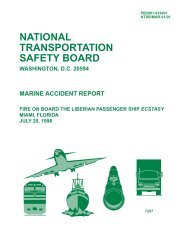Soot Deposits and Fires in Exhaust Gas Boiler - Martin's Marine ...
Soot Deposits and Fires in Exhaust Gas Boiler - Martin's Marine ...
Soot Deposits and Fires in Exhaust Gas Boiler - Martin's Marine ...
- No tags were found...
You also want an ePaper? Increase the reach of your titles
YUMPU automatically turns print PDFs into web optimized ePapers that Google loves.
<strong>Soot</strong> <strong>Deposits</strong> <strong>and</strong> <strong>Fires</strong> <strong>in</strong> <strong>Exhaust</strong> <strong>Gas</strong> <strong>Boiler</strong>IntroductionThe dem<strong>and</strong> for the highest possibleoverall fuel efficiency is reflected <strong>in</strong> developmentsover the last two to threedecades <strong>in</strong> the propulsion market foroceango<strong>in</strong>g ships. Today, this market isdom<strong>in</strong>ated by highly efficient two-strokelow speed diesel eng<strong>in</strong>es which run onlow quality fuels <strong>and</strong> utilise (recover) theexhaust gas heat by means of an exhaustgas boiler/economiser.In the same period, reduced specificfuel oil consumption, i.e. <strong>in</strong>creasedthermal efficiency of the diesel eng<strong>in</strong>e,has resulted <strong>in</strong> lower exhaust gas temperatures.Based on ISO ambient referenceconditions (25°C air <strong>and</strong> 25°Ccool<strong>in</strong>g water), <strong>and</strong> with the presentnom<strong>in</strong>al rat<strong>in</strong>gs of the MC/MC-C <strong>and</strong>ME/ME-C eng<strong>in</strong>es, the exhaust gastemperature after the turbocharger isabout 240-270°C, but may be lower forderated eng<strong>in</strong>es.The name “exhaust gas economiser” isoften used for an exhaust gas boiler whichis not able to operate separately, i.e.without its own steam drum. In thispaper, the name “exhaust gas boiler”will be used <strong>in</strong> general, also <strong>in</strong> caseswhere “exhaust gas economiser”, <strong>in</strong>pr<strong>in</strong>ciple, should have been used.Rise <strong>in</strong> soot fire <strong>in</strong>cidentsAs a consequence of the lower exhaustgas temperatures <strong>and</strong> the rema<strong>in</strong><strong>in</strong>gsteam consumption requirements, theexhaust gas boiler has been designedto become more <strong>and</strong> more efficient.This <strong>in</strong>volves the use of a large heattransfer surface <strong>and</strong> thus a boiler designwith a low <strong>in</strong>ternal gas velocity as wellas tubes with “extended” surfaces.Furthermore, the quality of the fuels hasdecreased significantly dur<strong>in</strong>g the sameperiod. Whereas the average fuel qualitymay not have deteriorated as muchNumber of soot fire/overheat<strong>in</strong>g <strong>in</strong>cidents per year7060504030201001982 84 86 88 90 92 94 96 98 00 2002 2004YearFig. 1: Number of soot-fire-damaged exhaust gas boilers <strong>in</strong> DnV- classed vesselsThis document, <strong>and</strong> more, is available for download at Mart<strong>in</strong>'s Mar<strong>in</strong>e Eng<strong>in</strong>eer<strong>in</strong>g Page - www.dieselduck.net3
















